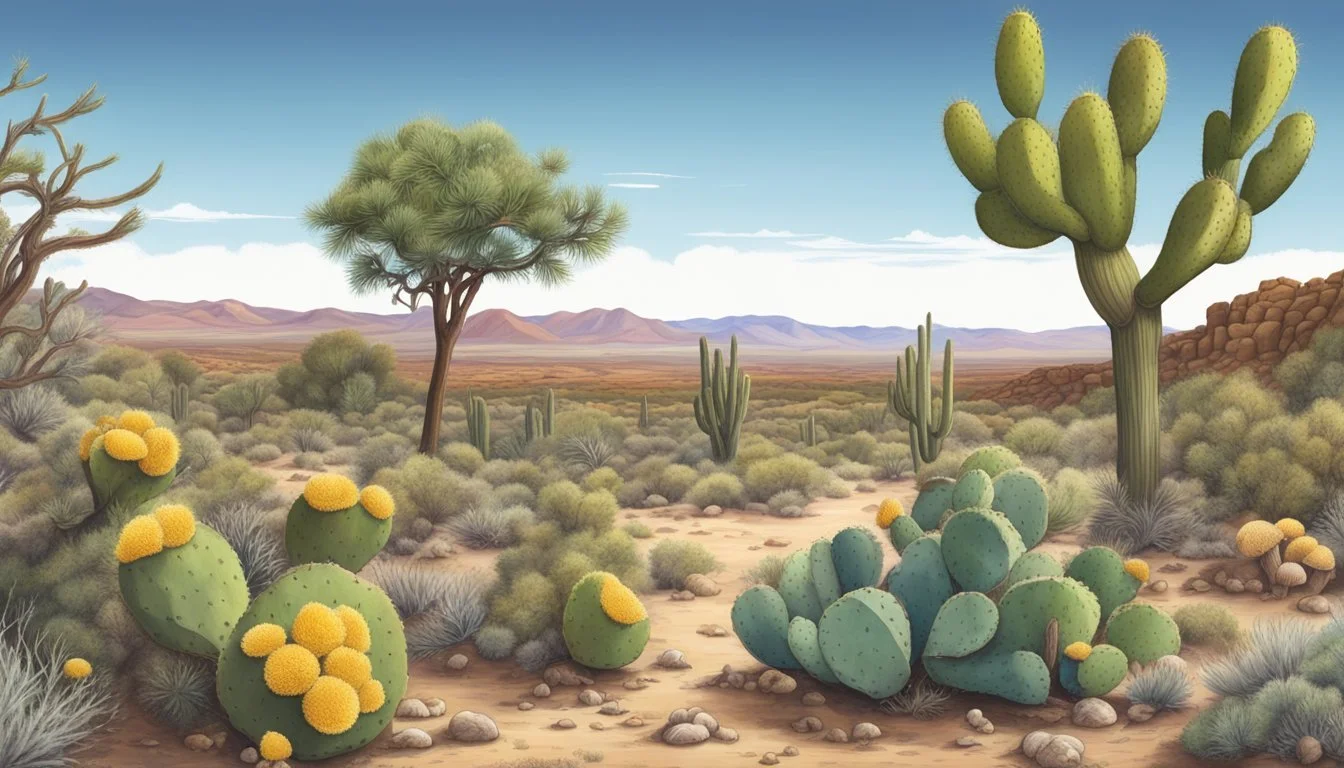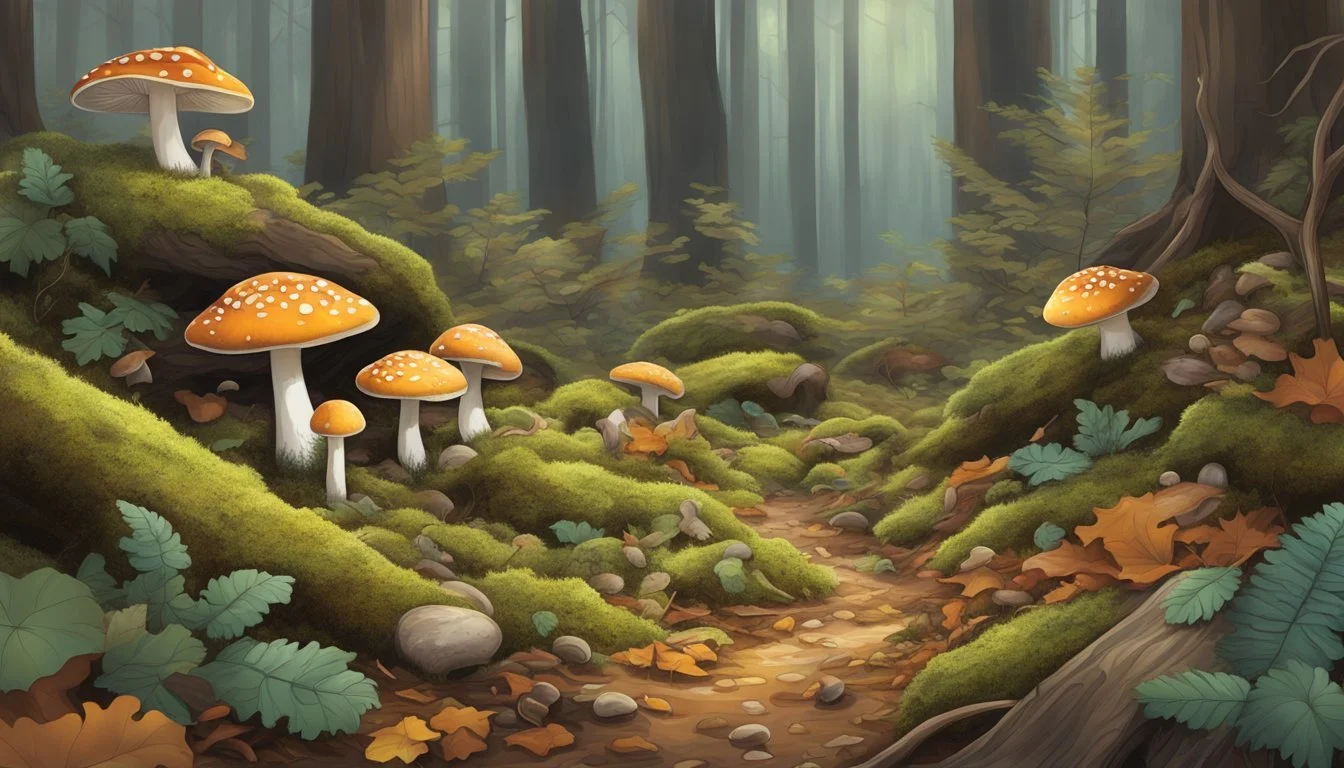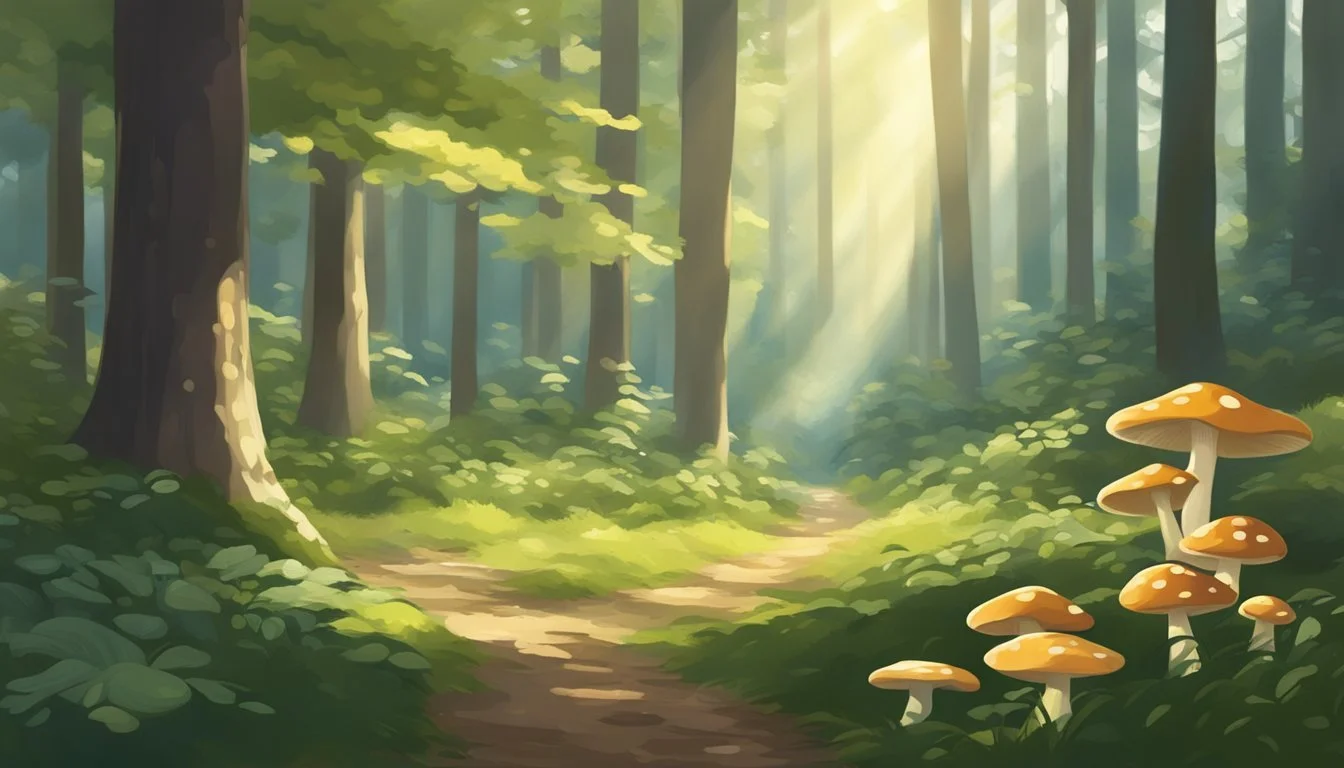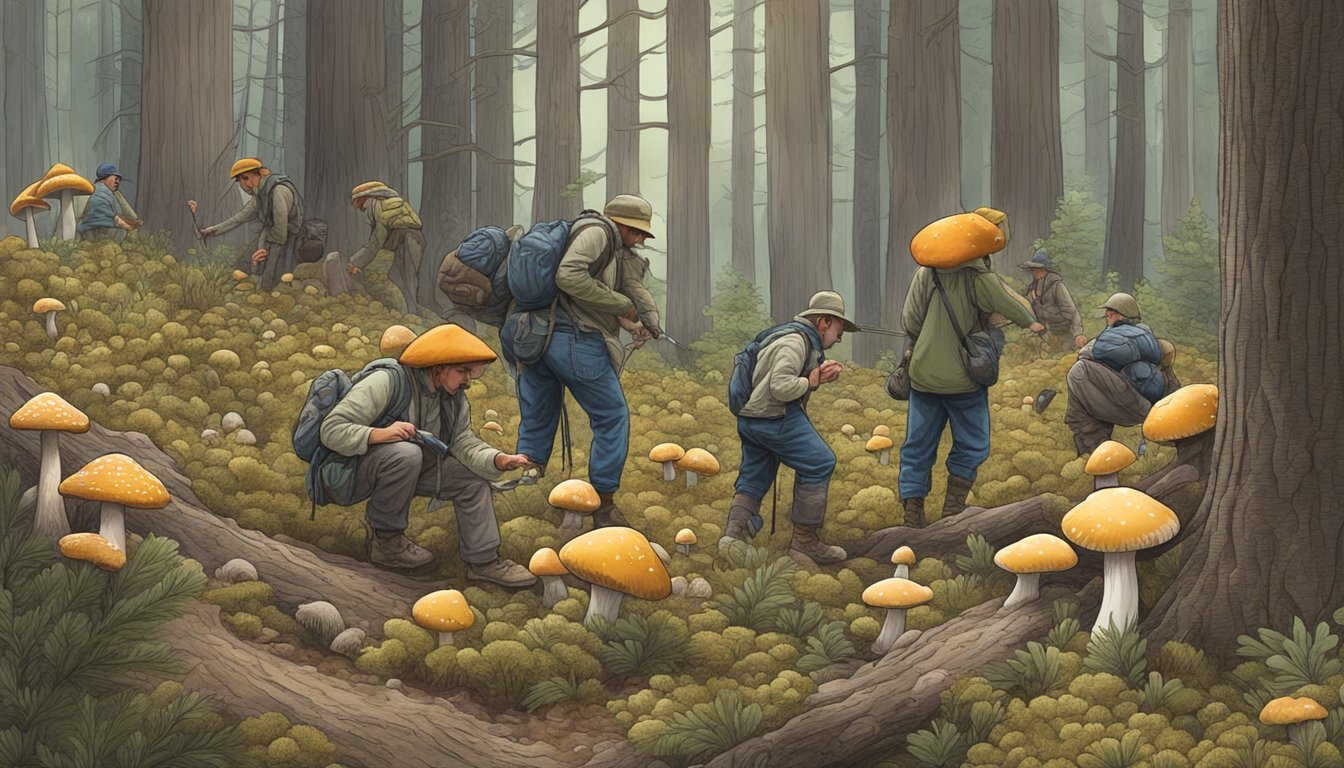Mushroom Hunting New Mexico
A Guide to the Best Foraging Spots
This Article is Part of Our Guide on Mushroom Hunting for All 50 States
Mushroom hunting in New Mexico offers a unique experience for enthusiasts and nature lovers alike. The state's varied landscapes, from desert plains to mountainous regions, create an array of habitats suitable for different mushroom species. Foragers can find a fascinating variety of fungi, including the vibrant Turkey-tail and even the elusive Witch's Butter. However, it is crucial for hunters to be aware that foraging is not permitted within New Mexico state parks, ensuring conservation of these natural areas.
As they traverse through New Mexico's great outdoors, foragers need to be educated and cautious. Accurate identification is paramount as some species, such as the Amanita muscaria, are highly toxic. Mushroom hunters should never consume a mushroom unless they are absolutely certain of its safety. By using resources like local mushroom guides and participating in foraging tours or classes, individuals can enrich their knowledge and forage responsibly.
Safety measures such as making a spore print can aid in differentiating between mushroom species, as many can appear similar to the untrained eye. The importance of exercising this level of care cannot be overstated, due to the potential risks associated with misidentified mushrooms. With responsible practices, mushroom hunting in New Mexico can be a rewarding activity that connects individuals with nature and the rich mycological diversity the state has to offer.
Foraging for More Than Just Mushrooms in New Mexico
New Mexico's unique landscapes, from the Chihuahuan Desert to the Sangre de Cristo Mountains, offer a surprising array of wild edibles for the intrepid forager. While mushrooms are a prized find, the Land of Enchantment's diverse ecosystems provide a bounty of cacti fruits, wild herbs, nuts, and greens. Discover the flavors of the Southwest and connect with nature through foraging in New Mexico.
👉 Foraging for Wild Edibles in New Mexico
Commonly Found Edible Mushrooms in New Mexico
New Mexico is home to several edible mushroom species. Some of the most commonly found edible mushrooms in the state include:
King Bolete (Boletus edulis): Commonly found in New Mexico, the king bolete is a sought-after edible mushroom with a meaty texture and a nutty, earthy flavor, making it a prized find for foragers and chefs alike.
Puffball Mushroom (Calvatia spp): Often found in New Mexico, puffball mushrooms are characterized by their round, white fruiting bodies and are known for their mild flavor and versatile culinary uses.
Chicken of the Woods (Laetiporus sulphureus): Frequently found in New Mexico, these vibrant orange shelf-like mushrooms have a soft texture and a flavor reminiscent of chicken, making them a popular choice for cooking and foraging.
Maitake (Grifola frondosa): Also known as hen of the woods, these mushrooms grow at the base of oak trees in New Mexico and have a rich, earthy flavor and a distinctive, frilly appearance, making them a prized culinary ingredient.
Oyster Mushroom (Pleurotus spp): Commonly found growing on decaying hardwood trees in New Mexico, oyster mushrooms have a delicate flavor and a velvety texture, making them a versatile and widely used culinary ingredient.
Lobster Mushroom (Hypomyces lactifluorum): Commonly parasites on Russula or Lactarius species. Distinct, bright orange to red coloring; it boasts a seafood-like flavor similar to that of cooked lobster.
Lion’s Mane (Hericium erinaceus) Found on both dead and living trees. Unique, shaggy appearance, resembling a pom-pom; has a seafood-like taste when cooked.
Chanterelles (Cantharellus spp): Under hardwood trees, particularly oaks, in the summer and fall, Trumpet shape, yellow to orange color, with a fruity and peppery taste.
Morels (Morchella spp): Trumpet shape, yellow to orange color, with a fruity and peppery taste, Honeycombed cap, hollow stem, and prized for their nutty flavor.
It is essential to properly identify any mushroom before consuming it, as some species can be poisonous. Beginners should go mushroom hunting with an experienced guide or join a local mycological society to learn how to identify edible mushrooms safely.
Essentials of Mushroom Hunting
The pursuit of mushroom hunting in New Mexico requires a detailed knowledge of fungal ecology and a strong adherence to safety and ethical guidelines. A successful forager respects the environment and understands the risks involved with handling fungi.
Understanding Fungi Ecology
Mushrooms are the fruiting bodies of fungi and are a vital part of forest ecosystems, involved in decomposition and nutrient cycling. They propagate through spores, which are spread by wind or animals. For a successful hunt, one needs to know that mushrooms prefer moist, organic environments and often associate with specific types of trees. In New Mexico, morels are commonly found near ash or aspen trees and are most abundant from late March to May.
Safety and Ethical Considerations
Before handling any mushrooms, it's crucial to recognize that some are toxic. Proper identification is essential; a forager should never consume mushrooms unless they are absolutely certain of their safety. Always carry a field guide or use a credible app for identification.
Ethics play a large role in foraging. One should:
Only take what they will use, leaving enough for wildlife and for the fungi to reproduce.
Avoid damaging the mycelium, the vegetative part of the fungus, which is vital for the ecosystem.
Clean any collected mushrooms on site to prevent the spread of invasive species.
Best Times for Hunting
Mushroom hunting in New Mexico is a rewarding activity that requires timing one's excursions to align with specific environmental conditions when mushrooms are most likely to flourish.
Seasonal Weather Patterns
Spring, especially the months of March to ** poetic**, and late summer are key periods for mushroom hunters in New Mexico. The onset of the monsoon season in late summer brings afternoon thunderstorms, contributing to the moisture mushrooms need for growth. March marks the beginning of the foraging season for certain varieties like morels, but the majority of mushrooms thrive during the rainy periods of late summer/at monsoon season.
Optimal Temperature Conditions
The temperature Morrow is another critical factor for mushroom hunting. Spring temperatures are often moderate, favoring mushroom growth. By May, warmer soil temperatures trigger the emergence of several mushroom species. In contrast, late summer temperatures can be varied, but the combination of warmth and increased moisture from the monsoon season creates ideal conditions. Rain followed by warm afternoons can significantly enhance mushroom production.
While afternoon thunderstorms are a hallmark of the monsoon season in New Mexico, they also suggest late afternoon or next-day hunting trips, as mushrooms tend to emerge following substantial rainfall.
Popular Mushroom Species in New Mexico
New Mexico's diverse ecosystems offer a rich variety of fungi, from highly sought-after edibles to dangerously toxic species. This section provides guidance on which mushrooms enthusiasts typically seek out for culinary use and which ones they should carefully avoid during their foraging adventures.
Toxic Mushrooms to Avoid
Fly Agaric (Amanita muscaria)
Hazard: Illness can occur, with potentially severe neurological effects.
Identification: Iconic red cap with white spots, found beneath pine and birch trees.
Amanita Muscaria Variants
Hazard: These are potentially deadly and demand expert differentiation.
Identification: Includes variants of Fly Agaric; best avoided due to variability and high risk.
Certain Russula and Boletes Species
While many are edible, some species can be confused with their toxic look-alikes. Positive identification is crucial.
Remember, it’s essential for mushroom foragers to properly identify and know the habitat of each mushroom species before consumption. One should never consume wild mushrooms without absolute identification and often a consult from a mycology expert.
Where to Hunt
Mushroom hunting in New Mexico offers a variety of locations, with the best yields often found in the state's forests and mountainous regions, as well as state parks and protected areas. Accurate knowledge of these habitats and their respective growth conditions is crucial for a successful foray.
Forests and Mountainous Regions
In New Mexico, forests and mountainous areas tend to be prime mushroom hunting locales, particularly at higher elevations where environmental conditions are favorable. The Taos Ski Valley, renowned for a diversity of fungi, exemplifies the ideal mushroom habitat due to its wooded terrain and elevation. Hunters should monitor the aspects of the mountain trails to determine the most fruitful areas, keeping in mind that the north-facing slopes are typically moister and cooler.
Key Locations for Mushroom Hunting:
Taos Ski Valley: Provides a range of elevations and forest types.
Lincoln National Forest: Diverse ecosystems support a variety of mushroom species.
State Parks and Protected Areas
State parks and protected areas in New Mexico also offer an array of mushroom hunting grounds. Dedicated resources such as Mushroom Maps and the New Mexico Mushroom Guide can assist foragers in identifying potential spots within these regions. Hunters should check for permits or regulations before foraging, as some parks may impose restrictions to preserve natural resources.
Recommended State Parks:
Fenton Lake State Park: Known for rich fungal diversity due to its mixed coniferous and deciduous forests.
Hyde Memorial State Park: Offers a variety of trails with different aspects and vegetation types.
Foragers are encouraged to be respectful of the environment and practice sustainable harvesting to maintain the natural balance of these delicate ecosystems.
Preparation for the Hunt
When embarking on a mushroom hunt in New Mexico, individuals should prioritize safety, adequacy of gear, and a respectful understanding of local customs. Appropriate preparation not only enhances the experience but also supports sustainable harvesting practices.
Essential Gear and Equipment
A mushroom hunter's gear plays a crucial role in the success and safety of their forage. Below are the key items they'll need:
Knife: A sharp knife is vital for cleanly cutting mushrooms.
Basket or Mesh Bags: To avoid damaging the forage, baskets or mesh bags are preferred over plastic bags for ventilation.
Field Guide: A regional mushroom field guide assists in correct identification.
Compass/GPS: Reliable navigation tools are essential to prevent getting lost during the hunt.
Sturdy Boots: To navigate the varied terrain, a hunter needs durable and comfortable hiking boots.
Water: Staying hydrated is vital; hunters should carry ample water.
Protective Clothing: Long sleeves and pants protect against the underbrush and insects.
Cultural Insights and Local Practices
Mushroom hunting in New Mexico is not only about gathering edible fungi but also about appreciating local traditions and ecological practices:
Sustainable Foraging: They practice conscious foraging by only taking what they need and leaving enough for regrowth.
Respectful Interaction: Hunters are mindful of the environment and the local community, understanding that they are participants in a larger ecosystem.
Knowledge Sharing: Experienced foragers often share insights with novices to ensure respectful and knowledgeable hunting.
Collaboration with Local Experts: Seeking advice from local mycologists or joining mushroom hunting groups can be invaluable.
Identifying and Collecting Mushrooms
In New Mexico, mushroom hunting can be a rewarding activity, provided one has the knowledge to correctly identify various mushrooms. Two key techniques in the identification process are the use of spore prints and the recognition of specific mushroom features.
Using a Spore Print
A spore print is a mushroom's fingerprint, providing critical information about its identity. To create a spore print, one must:
Remove the cap from the stalk.
Place the cap, gills or pores downward, on a piece of white paper for light-colored spores or black paper for dark spores.
Cover with a bowl to prevent air currents from dispersing the spores.
Wait for several hours to overnight until spores are released and leave a print.
Spore prints reveal the spore color, which ranges from white to black, including shades of yellow, brown, and pink. Since many mushrooms have similar appearances, spore color is an invaluable trait for differentiating species.
Recognizing Mushroom Features
The following features are crucial for mushroom identification:
Type of Mushroom: Classify whether the mushroom is gilled, pored, or has other spore-bearing structures.
Colors: Observe the cap, gills, pores, stalk, and any bruising reactions to touch or age.
Sizes: Measure cap width and stalk height and thickness.
Forms: Note the shape of the mushroom's cap (e.g., flat, convex, conical), the presence of a ring on the stalk, and the form of the base (e.g., bulbous, rooted).
Mushrooms in New Mexico come in various colors and sizes. For instance, the Turkey-tail Mushroom (Trametes versicolor) often displays rings of different colors and measures up to 8 cm in length. Accurate observations and measurements are essential in distinguishing edible species from toxic ones and should always be carried out with caution, as mushrooms like the fly agaric (Amanita muscaria) can be highly toxic despite their attractive appearance.
Understanding the Environment
Successful mushroom hunting in New Mexico requires an in-depth comprehension of the local environment. Each mushroom species thrives under specific conditions influenced by soil type, acidity levels, and surrounding vegetation.
Soil Types and Acidity
Mushrooms demand particular soil types and acidity to flourish. Morel mushrooms, for example, prefer calcareous (chalky) and loamy soils with a pH level above 6, leaning toward slightly alkaline conditions. Prospective hunters should also note the topographical nuances, such as altitude and slope, that can affect the distribution of mushrooms.
Host Trees and Vegetation
The types of trees and vegetation prevalent in an area can indicate the presence of certain mushroom species. Morels find symbiotic relationships with certain trees, commonly thriving near ash or aspen. Other species, like those in the conifer family including fir and spruce, are also known to favor mushrooms due to their contribution to the leaf litter and soil composition beneficial for mycelium growth.
Mycological Resources and Support
In New Mexico, individuals interested in mushroom hunting can rely on established organizations for education and support. These entities provide essential resources to both amateur and professional mycologists.
New Mexico Mycological Society
Founded: [Unknown] Location: Albuquerque, NM Web: nmms.info Meetings: First regular meeting typically in March Membership Likes: Approximately 1,950 on social media
The New Mexico Mycological Society (NMMS) is based in Albuquerque and serves as a hub for those with an interest in wild mushrooms and fungi. They hold regular meetings, with the first of the year usually in March, and encourage the study of mycology through educational events. Membership engagement is evident through their social media presence, which boasts a substantial following.
North American Mycological Association
Founded: [Unknown] Status: Nonprofit 501(c)(3) Affiliations: Over 90 mycological societies Web: namyco.org
The North American Mycological Association (NAMA) is recognized for its contributions to mycology at a larger, continental scale, including the United States, Canada, and Mexico. The association supports the growth of mycology as a discipline and provides resources for mycologists of all levels. By affiliating with over 90 mycological societies, NAMA promotes sustainable and responsible mushroom gathering practices and ensures that fungi and their habitats are preserved.
After the Hunt
After a successful foray into the mushroom-rich environments of New Mexico, the bounty of fungi collected offers an exciting opportunity for culinary exploration. However, one must carefully clean and preserve their findings before they can be safely and deliciously incorporated into meals.
Cleaning and Preservation
Once they have returned from foraging, individuals should clean their mushrooms with a gentle brush or a damp cloth to remove debris. It's important not to wash the mushrooms directly under water as they can absorb moisture and spoil more rapidly. For mushrooms like chanterelles and morels, which may have dirt trapped in their ridges, a soft brush works best.
For preservation, mushrooms can be categorized based on their durability:
Delicate Varieties (e.g., oyster mushrooms):
Best used immediately
Can be stored in the refrigerator for a few days in a paper bag
Sturdier Varieties (e.g., porcini):
Can be sliced and air-dried
Suitable for freezing or dehydrating
Proper preservation ensures that the unique flavours and textures of each specimen are maintained until they are ready to be used in cooking.
Cooking and Recipes
Once cleaned and preserved, the mushrooms can be transformed into a variety of dishes. Cooking methods and recipes are often dictated by the specific type of mushroom and desired flavour profiles. Here are some specific suggestions:
Chanterelles: Sautéed with garlic and herbs, these can be a flavorsome addition to tacos or pasta dishes.
Morels: Ideal for creamy sauces to accompany meats or as a rich ingredient in risottos.
Individuals should adjust cooking times and seasoning based on the specific conditions of each mushroom type to achieve the best results. For instance, some mushrooms may release a lot of water and would benefit from longer cooking times to concentrate their flavors.
Contributing to the Community
Mushroom hunting in New Mexico not only fosters a personal connection with nature but also plays a significant role in enriching the local mycological community. Through sharing findings and participating in events, enthusiasts contribute to a collective understanding and appreciation of the region's fungal diversity.
Sharing Findings and Experiences
Mushroom hunters in New Mexico actively engage with communities, such as the New Mexico Mushroom Society and the Mushroom Hunters of New Mexico, by sharing their discoveries and experiences. They often post photos, location data, and anecdotes about their foraging expeditions, which may include:
Species identification
Habitat notes
This exchange of information promotes awareness and educates newcomers about the importance of recognizing edible versus toxic species.
Participation in Local Events
Members of the mycological society and hobbyists partake in local events that celebrate and disseminate knowledge about mushrooms. Events can range from:
Educational workshops
Mycological fairs
Foraging excursions
By participating, individuals aid in cultivating a culture of safety, conservation, and responsible foraging practices.











